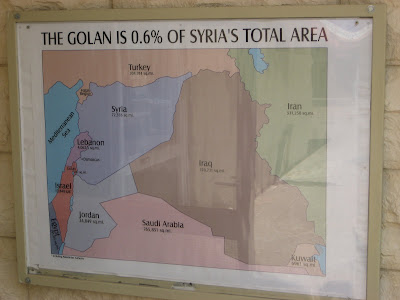Crossing the Jordan. It's much more substantial here (above the Kinneret) than at the Allenby Bridge.

The "Talmudic village" in Katzrin. Like Beit She'an, Katzrin was destroyed in the earthquake of 749. Unlike Beit She'an, it was a Jewish town, and not everything in the archaeological park is real -- some of it is a reconstruction.



As it happened, there was a wedding going on. The actual ceremony had taken place in ancient Katzrin's synagogue.


UPDATE: A video capturing the scene:
Some of these artifacts have questionable authenticity.


[UPDATE: In addition to the archaeological remains and reconstructions, ancient Katzrin also boasts the "Talmudic Experience", which is a movie shown on 6 screens! The 6 screens are all around the room, so from anywhere you sit, you can see 3 screens at once. I think there are only 3 different images shown at a time, and the other 3 screens duplicate those. There were two options for movies: "The Oven of Akhnai" and "Rabbi Meir and Aheir". But we didn't get to choose - we got the latter.
Since we were the only people there at the time and our native language was English, they showed us the version dubbed into English, which also had English text flashing dramatically across the screen. The translation was laughable at times, and only made sense to us because we knew the Hebrew behind it, e.g. "The Signing of the Mishnah" (חתימת המשנה) and "Just a statement of Rabbi Meir" (סתם משנה רבי מאיר).
Still, the movie was fun. It was a dramatization of the story, with period costumes and all the rest. And it was clearly intended for today's Israeli audience. When Elisha ben Avuyah showed up to Rabbi Meir's beit midrash on horseback on Shabbat, everyone involved (we hear the story from one of Rabbi Meir's students) is absolutely shocked. And then Rabbi Meir goes off to talk with Elisha, with Rabbi Meir walking and Elisha riding his horse. This scene fades into a modern scene with a supposedly secular Israeli man (with sunglasses) driving a car (very very slowly) and a man with a black hat and tallit walking next to him. "Can you imagine this kind of interaction between religious and secular Jews today? AND, the one in the car is the teacher, and the one walking is the student, still learning from his teacher!" It's a good point. Not so likely to happen today.]
Did you ever wonder where those העם עם הגולן bumper stickers come from? Now we know the answer: the Golan propaganda office is a storefront in "downtown" Katzrin (which is basically one small street).

My view on the Golan is very different from my view on the West Bank and Gaza. Israel has annexed the Golan (so that Israeli law is in effect there), and (regardless of the circumstances that led to this) there is no disenfranchised local population lacking self-determination. Therefore, the Golan is just land. Land can change hands as a result of wars (war sucks, but it happens; Germany lost a lot of land to Poland in World War II) or peace negotiations. Holding onto the Golan isn't destroying Israel, the way the West Bank and Gaza are. (The issue with the West Bank and Gaza, as I see it, isn't the land, but the 3 million disenfranchised Palestinians.) So I don't think it's problematic for Israel to be currently controlling the Golan, and Israel may or may not give the Golan back in future peace negotiations with Syria, if the citizens of Israel (through their elected leaders) weigh the costs and benefits and decide that it's a good idea.
So I can understand how posters like this would be intended to convince people like me that it's not a good idea:

But on the other hand, I can't see what the following poster is trying to show. Either Israel's claim on the Golan is legitimate, or it isn't. If it isn't, then it doesn't matter what percent of Syria's total area the Golan is -- it's still wrong for Israel to be there. (If you shoplift $100 from Wal-Mart, you're not going to get off in court by saying it's a tiny percentage of Wal-Mart's total assets.) And if it is (which I think it is, insofar as anything in war is legitimate), then it also doesn't matter -- the Syrians (who aren't reading this poster) are the ones who should determine how valuable the Golan is to them, and the Israelis can do likewise for themselves, and then (bimheirah v'yameinu) enter into negotiations based on this.

That last poster is really bad.
ReplyDeleteMy attitude toward the Golan, and Syria is that it is not reasonable to engage in war without assuming the risk that you will lose territory in doing so. Syria engaged the war, and lost the territory. Too bad, so sad.
As for the West Bank and Gaza. . . I can understand why annexation isn't an option, but, had Israel known in 67 that it would still be dealing in 2007, perhaps it would have taken a Marshall plan approach, really building up the territories for the Pals and then letting them fight a perfunctory war of independence.
Hi,
ReplyDeleteThere are several hundred thousand disenfranchised Golan residents, they just are no longer on the Golan.They fled the area / were kicked off their land during the 1967 war. Although the remaining Syrians who still live on the Golan have the option of Israeli citizenship, the vast majority have refused and consider themselves subjects of Syria.
The relevance of the size of the Golan to Syria is that we should view with skepticism and even cynicism the claim by the government of Syria that the return of the Golan is such a crucial national interest that peace with Israel depends upon the return of that territory.